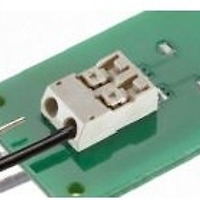R&TTE 제한없이 사용할수 있는 저출력 무선기기
ANNEX 1: NON-SPECIFIC SHORT RANGE DEVICES
Scope of Annex
This annex covers frequency bands and regulatory as well as informative parameters recommended primarily for Telemetry, Telecommand, Alarms and Data
in general and other similar applications. Video applications should be preferably used above 2.4 GHz.
This annex also includes references to the generic UWB regulation which was primarily developed to allow communication applications using UWB
technology in bands below 10.6 GHz; but enables also other types of radio applications.
Regulatory parameters
Note 1: When either duty cycle, Listen Before Talk (LBT) or equivalent technique applies then it shall not be user dependent/adjustable and shall be guaranteed by appropriate technical means.
For LBT devices without Adaptive Frequency Agility (AFA), or equivalent techniques, the duty cycle limit applies.
For any type of frequency agile device the duty cycle limit applies to the total transmission unless LBT or equivalent technique is used.
Note 2: The preferred channel spacing is 100 kHz allowing for a subdivision into 50 kHz or 25 kHz.
Note 3: Sub-bands for alarms are excluded (see ERC/REC 70-03 Annex 7).
Note 4: Audio and video applications are allowed provided that a digital modulation method is used with a max. bandwidth of 300 kHz.
Analogue and digital voice applications are allowed with a max. bandwidth ≤ 25 kHz.
In sub-band 863-865 MHz voice and audio conditions of Annexes 10 and 13 of ERC/REC 70-03 apply respectively.
Note 5: Duty cycle may be increased to 1% if the band is limited to 865-868 MHz.
Note 6: For wide-band techniques, other than FHSS, operating with a bandwidth of 200 kHz to 3 MHz, the duty cycle can be increased to 1% if the band is limited to 865-868 MHz and power to
≤10 mW e.r.p.
Note 7: The power density can be increased to +6.2 dBm/100 kHz and -0.8 dBm/100 kHz, if the band of operation is limited to 865-868 MHz and 865-870 MHz respectively.
Note 8: These limits should be measured with an rms detector and an averaging time of 1 ms or less.
Note 9: The available channel centre frequencies are 916.3 MHz, 917.5 MHz, 918.7 MHz and 919.9 MHz. The channel bandwidth is 400 kHz.
Note 10: RFID tag emissions responding to RFID interrogators operating on centre frequencies 916.3 MHz, 917.5 MHz, 918.7 MHz and 919.9 MHz are not duty cycle limited.
Note 11: Audio and video applications are excluded. Voice applications (analogue or digital) are allowed with a maximum bandwidth of ≤ 25 kHz, and with spectrum access technique such as LBT
or equivalent and shall include a power output sensor controlling the transmitter to a maximum transmit period of 1 minute for each transmission.
Additional Information
Harmonised Standards
EN 300 220 sub-bands c) to g3.1)
EN 300 330 sub-bands a) to c)
EN 300 440 sub-bands h) i) and j)
EN 305 550 sub-bands k), k1), l), l1) and m)
EN 302 065 sub-band n)
EN 302 500 sub-band n) (only 6-9 GHz)
Technical parameters also referred to in the harmonised standard
Listen before talk (LBT) with Adaptive Frequency Agility (AFA) technique feature may be used instead of duty cycle.
LBT is defined in EN 300 220.
Audio and voice are defined in EN 300 220.
Frequency issues
The bands in Annex 1 a - b - c - d f - f1 - f2 - h - i - j - k - l and m are also designated for industrial, scientific and medical (ISM) applications as defined in ITU
Radio Regulations.
Band g1)
Certain channels may be occupied by RFID operating at higher powers (See Annex 11 for further details). To minimise the risk of interference from RFID,
SRDs should use LBT with AFA or observe suitable separation distances. (In the high power RFID channels typically these may vary from 918 m (indoor) to
3.6 km (rural outdoor). In the remaining 2.2 MHz, where tags at -20 dBm e.r.p. occupy the spectrum, this may vary from 24 m (indoor) to 58 m (rural
outdoor)).
The adjacent frequency bands below 862 MHz and above 870 MHz may be used by high power systems. Manufacturers should take this into account in the
design of equipment and choice of power levels.
Sub-bands g2) to g3.1)
Use of all or part of sub-bands g2) to g3.1) may be denied in some European countries that use all or part of these sub-bands for defence/governmental
systems. In other countries that use sub-bands 873-876 / 918-921 MHz for GSM for railways, extended band (ER-GSM), access to the part 873-876 / 918-
921 MHz by non-specific SRD applications require implementing additional mitigation measures such as transmission timing limitations as set out in ECC
Report 200. See Appendix 3 for national implementation concerning ER-GSM and defence/governmental services.
The adjacent frequency bands below 915 MHz and above 876 MHz as well as 921 MHz may be used by high power systems. Manufacturers should take this
into account in the design of equipment and choice of power levels.
'인증' 카테고리의 다른 글
| 엔트리뉴스 2014-03호 _ LED & OLED EXPO 2014 / 엔트리 연구원 연재 시리즈 / 해외 LED 관련 동향 (0) | 2014.07.28 |
|---|---|
| [SRRC인증] 중국 통신제품형식승인 (0) | 2014.07.25 |
| [ISO인증] ISO 9001:2015 개정판 안내 (0) | 2014.07.25 |
| [산업통상자원부고시 제2014-35호] 고효율에너지기자재 보급촉진에 관한 규정 (0) | 2014.07.25 |
| [효율관리제도] 한국몰렉스, LED 조명 애플리케이션을 위한 로우 프로파일 Lite-Trap 전선 대 기판 커넥터 출시 (0) | 2014.07.08 |
| [효율관리제도] "건물 에너지 효율 고려 도시계획 세워야" (0) | 2014.07.08 |
| [일본인증] JAPAN MIC인증 (구 TELEC) _ LED조명 인증전문 _ 엔트리연구원 (0) | 2014.07.03 |
| [호주인증] RCM인증 _ LED인증의 모든것 _ 엔트리연구원 (0) | 2014.07.02 |



